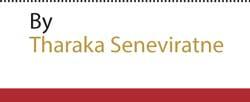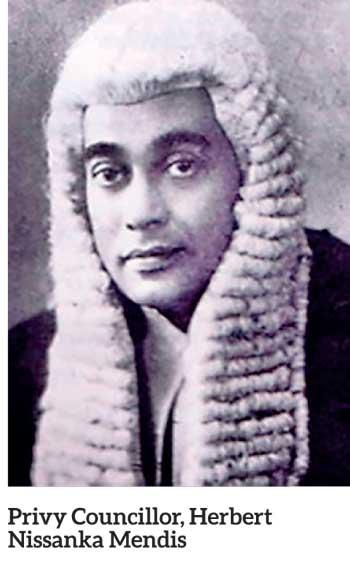09 Mar 2024 - {{hitsCtrl.values.hits}}
 In the pre-independence era, mother Lanka was blessed with several iconic leaders dedicated to the upliftment of civil society in the long run. Privy Councillor, Herbert Nissanka Mendis (H. Sri Nissanka) was an unsung contemporary, but undoubtedly the par excellence. Though being educated in Europe, he preferred the common village man’s simple way of life. His own was a lifestyle inspired by the Buddhist way of simplicity, purity and humility – the unassuming grandeur of a great visionary. He was an intellectual who could never be bought over to do an ill deed against his beloved motherland.
In the pre-independence era, mother Lanka was blessed with several iconic leaders dedicated to the upliftment of civil society in the long run. Privy Councillor, Herbert Nissanka Mendis (H. Sri Nissanka) was an unsung contemporary, but undoubtedly the par excellence. Though being educated in Europe, he preferred the common village man’s simple way of life. His own was a lifestyle inspired by the Buddhist way of simplicity, purity and humility – the unassuming grandeur of a great visionary. He was an intellectual who could never be bought over to do an ill deed against his beloved motherland.
He was born in 1898 at the famous Garumuni Walawwuwa of Balapitiya in Southern Ceylon, as the only son of Diveris Mendis and dame, Anoma Wickremaratne Soyza. His parents had three other daughters. After he completed primary education at Ananda College and thereafter at Royal College, it was the joint view of the family – especially that of the civic leader, Sir D.  B. Jayatilleke – that the youngster should enrol at Oxford University in Great Britain and be fortified with expert knowledge in law. That was indeed most fortunate because that was where he met S.W.R.D. Bandaranaike, a future Premier of independent Sri Lanka.
B. Jayatilleke – that the youngster should enrol at Oxford University in Great Britain and be fortified with expert knowledge in law. That was indeed most fortunate because that was where he met S.W.R.D. Bandaranaike, a future Premier of independent Sri Lanka.
Prior to sailing to England, young Nissanka had been an ordained Buddhist monk for four years in then Burma, and he had been gifted with the uncanny knowledge of discerning the character and the future of anyone by assessing body features. Perhaps it was that knowledge that enabled young Nissanka to see the future of young Solomon Dias. The Solomon-Nissanka friendship that blossomed thereafter was the main influence in moulding a more Lankan oriented Bandaranaike in time to come.
On return as an Advocate from London, he had brilliantly defended and exonerated many in very difficult criminal proceedings, winning a name and a place of honour in the legal spheres in 30s and 40s. It is reported that even J.R. Jayewardene (the first Executive President of Sri Lanka) had understudied him as a rookie junior lawyer.
Eventually, he became very popular as an elite, surpassing nationalistic and religious boundaries so much so that he was elected as a Municipal Council member, uncontested. Subsequently, he was elected as the Member of Parliament for the Kurunegala Electorate in the first Parliament of Sri Lanka. It was during that period he was elected as the President of Sri Lanka Buddhist Congress. He was also nominated to represent Sri Lanka at many international forums, bringing credit to the country at large. Despite such a busy life, he was also the author of several books, namely, “A Critical Analysis on Ceylon Penal Code”, “The History of England”, “Salgala Puda Bima” (“The Salgala Monastery”), and “Athugalpura Satana” (“The battle of Kurunegala”). He was also the editor of two newspapers, “Sankha Nadaya” (The Clarion Call) and “Hela Diva.”
But it was his great service to the nation as a politician and founder of the SLFP that the common man will remember for generations to come. Being a man of true liberal views, he soon realised the need of the hour – a new political party for the common man; a driving force gathering the prelates (‘sangha’), ayurvedic physicians (‘veda’), teachers (‘guru’), farmers (‘govi’) and workers (‘kamkaru’) under the ‘Hand’ symbol to compete with the then governing political party.
Sri Nissanka, befitting to be named Sir Nissanka in view of his unparalleled service to the State, was never knighted; in fact, had he been knighted, that would have been an unpardonable insult to that unfathomable man.
His own mansion “Yamuna Ashram” at Kirulapona was the fertile ground where the like-minded young elites gathered, and the seeds of liberalistic views of national progression were planted for countering the outdated ways of aristocracy. He was truly a selfless man; he spent his wealth for growing that sapling party into a giant tree resulting in the resounding national victory at the very first election it faced. Then he selflessly entrusted its leadership to his friend, S.W.R.D. Bandaranaike, but continued to be the guiding force
behind the scene.
An anecdote recounted by his faithful driver shows that even during the pinnacle of his career as a prominent Privy Councillor, Sri Nissanka was conscious of his fellow men. During the malaria outbreak in 1934-35, Sri Nissanka went to the affected areas to distribute malaria medication. While returning he had swallowed quinine by mistake, and had developed serious ill effects. Always being the man with the presence of mind, he directed his driver to take him to Variyapola Police Station which was the closest at that point of the journey; he officially informed the mishap to the Police, with instructions that his poor driver should not be held responsible in the event of any tragedy. The OIC personally transported Sri Nissanka to Colombo General Hospital for timely treatment, averting a disaster in that great man’s life.
In 1954, when the country was passing a crucial time, Sri Nissanka passed away at 54; creating a void that cannot be filled, and leaving the SLFP and SWRD Bandaranaike to face the turmoil without his guidance.
There is a saying that the spouse is our better half. Nissanka’s beloved life partner Mrs. Murial Nissanka was an epitome to that saying. His children Yamuna, Geetha and Ranjith supported him throughout his illustrious civic works. Dr Avanthi Nissanka Karunaratne, Professor Randiv Nissanka Karunaratne, Ranjith Abeysekera and Devika Wickremaratne are some of his illustrious grandchildren. It is a pleasure to see that they have rallied together to continue with the “Nissanka tradition” of serving the mother land.
On Sri Nissanka’s 70th death anniversary, a commemorative ceremony accompanied by a book donation campaign was held on February 26 at Methmanga Meditation Centre, Rathgama, Galle. The event was held in collaboration with Methmanga TV Channel, according to the auspices of Jagath Gunetthi, Secretary of Sri Nissanka Memorial Foundation.
The writer is a retired Additional Director General of Customs
01 Jan 2025 34 minute ago
01 Jan 2025 1 hours ago
01 Jan 2025 2 hours ago
01 Jan 2025 3 hours ago
01 Jan 2025 4 hours ago